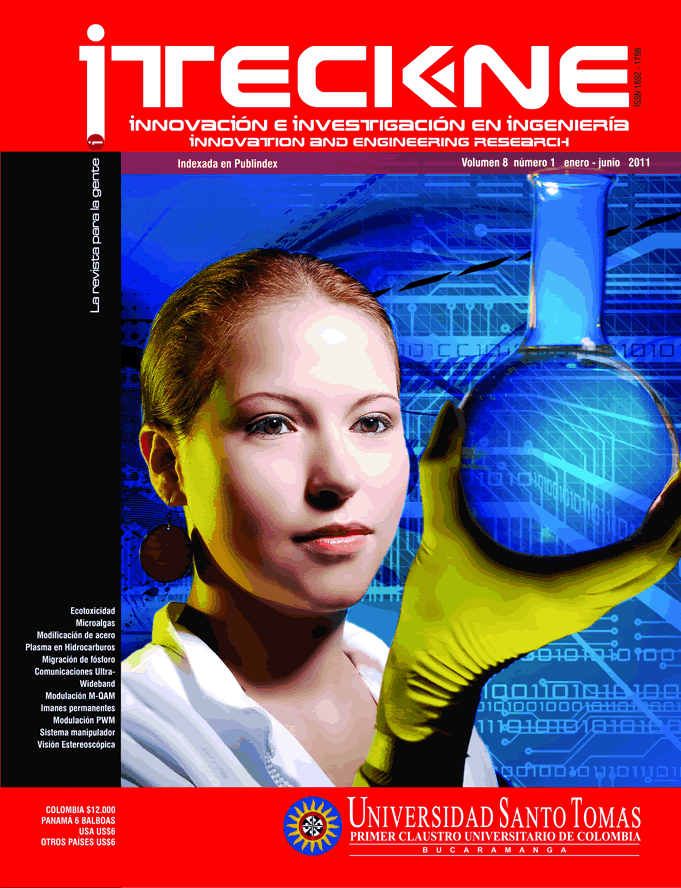Ecotoxicity test used to establish the genotoxic potential of sodium hypochlorite using onion bulbs of Allium cepa L and seeds of lettuce Lactuca Sativa L as bioindicators
Abstract
Se realizan pruebas de toxicidad mediante bulbos de cebolla (Allium cepa) y se confrontan los resultados con la prueba en semillas de lechuga (Lactuca sativa), bioindicador reconocido internacionalmente según la OECD. Las pruebas se montaron en hipoclorito de sodio (NaClO) al 5%, concentración comercial para uso doméstico. El objetivo principal de este trabajo es el de establecer el nivel de toxicidad de este producto y confrontarlo con las concentraciones de uso doméstico, siguiendo las recomendaciones del fabricante. Las plantas utilizadas como bioindicadoras permiten establecer las concentraciones de inhibición (CI50) y la genotoxicidad, a partir de las células meristemáticas de la cebolla (Allium cepa). Los resultados obtenidos son coincidentes, el hipoclorito de sodio es tóxico para ambas plantas, obteniéndose una CI50 de 17,27 mg NaClO/l para la lechuga (Lactuca sativa) e inferior a 5 mg NaClO/l para cebolla (Allium cepa), concentraciones muy inferiores a las que se usa en las dosificaciones domésticas. Se manifestaron aberraciones cromosómicas en células meristémicas de Alluim cepa como anafase con puente, rompimiento de cromosomas en metafase, malformación de células con núcleos periféricos y telofase con pérdida de cromosomas, todas estas reconocidas internacionalmente como aberraciones generadas por sustancias químicas tóxicas. Así mismo, se establece la especie Alliun cepa es más sensible que Lactuca sativa, y es viable realizar los montajes con cebolla a nivel de laboratorio. Sus resultados se constituyen como complemento en el diagnóstico genotóxico de aguas naturales o en ecosistemas receptores de vertimientos.
Downloads
References
[2] Newman, M. “Fundamentals of Ecotoxicology”. 2nd Ed. Lewis Publishers. CRC Press, Inc., Boca Ratón, Fl, pp. 1-250. 2001.
[3] Kruijf, H. A. M. What is Ecotoxicology. In: Kruijf, H. A. M.; Zwart, D.; Viswanathan, P.N. & Ray, P.K. (eds). Manual on aquatic ecotoxicology. Oxford: Klumer Academic Publishewrs, 1988. p: 18-21.
[4] Hayes, T., Case, P., Chui, S., Chung, D., Haeffele, C., Haston, K. “Pesticide mixtures, endocrine disruption, and amphibian declines: are we underestimating the impact?” Environ. Health Perspect., 114(1); 40–50. 2006.
[5] Fleeger, J., Carman, K., Nisbet, R. “Indirect effects of contaminants in aquatic ecosystems”. Sci. Total Environ., 317; 207–33. 2003.
[6] Kummerer, K. “Drugs, diagnostic agents and disinfectants in waste water and water—a review”. Chemosphere. 45; 957–69. 2001.
[7] Cedergreen, N., Kudsk, P., Mathiassen, S., Streibig, J. “Combination effects of herbicides on plants and algae: do species and test systems matter?”. Pest. Manag. Sci., 63; 282–95. 2007.
[8] Sørensen H., Cedergreen, N., Skovgaard, I., Streibig, J. “An isobole-based statistical model and test for synergism/antagonism in binary mixture toxicity experiments”. Environ. Ecol. Stat., 14, in press. 2007.
[9] Cedergreen, N., Kamper, A., Streibig J. “Is prochloraz a potent synergist across species? A study on bacteria, daphnia, algae and higher plants”. Aquat. Toxicol., 78; 243–52. 2006.
[10] Cedergreen, N., Kudsk, P., Mathiassen, S.K., Sørensen, H., Streibig, J. The reproducability of binary mixture toxicity studies. Environ.Toxicol. Chem. 26 (1); 149–56. 2007.
[11] OECD. GUIDELINE FOR THE TESTING OF CHEMICALS PROPOSAL FOR UPDATING GUIDELINE 208. Terrestrial Plant Test: 208: Seedling Emergence and Seedling Growth Test. DRAFT DOCUMENT. September 2003.
[12] Water Treatment Solutions- Lenntech. “Desinfectantes: Hipoclorito de sodio”. Disponible on line: http://www.lenntech.es/procesos/desinfeccion/quimica/desinfectantes-hipoclorito-desodio.htm.
[13] AISE. Association Internationale de la Savonnerie, de la Detergence el des Produits d’Entretien. Technical Task Force HYPOCLORITE. December, 13 pp. 1997.
[14] Monarca S, Rizzoni M, Gustavino B, Zani C, Alberti A, Feretti D, Zerbini I. “Genotoxicity of surface water treated with different disinfectants using in situ plant tests”. Department of Hygiene and Public Health, University of Perugia, Italy. 2003.
[15] Buschini, A., Carboni, P. M., Paola, F. P. & Rossi, C. “Sodium hypochlorite-, chlorine dioxide- and peracetic acid-induced genotoxicity detected by the Comet assay and Saccharomyces cerevisiae D7 tests”. Mutagenesis, 19 (2):157-162. 2004.
[16] Grant, W.F. “Chromosome Aberrations in Plants as a Monitoring System”. Environ. Health Perspect., 27(12): 37-43. 1978.
[17] Saleh, K., Khanfar, A. & Mosaad, I. “Detection of abnormal and micronucleus in root tips of Allium cepa cultivated in water wells”. Inter. J. App. Environ. Sciences, (Sept): 4pp. 2009.
[18] Monte-Egito, L. C., Medeiros, M., Batistuzzo de Medeiros, S. R. & Agnez-Lima, L. F. “Cytotoxic and genotoxic potential of surface water from the Pitimbu river, northeastern/RN Brazil”. Gen. & Mol. Biol., 30 (2): 435-441. 2007.
[19] Castillo, G (ed.). “Ensayos toxicológicos y métodos de evaluación de calidad de aguas. Estandarización, intercalibración, resultados y aplicaciones”. IDRC, IMTA, Canadá. 202 pp. 2004.
[20] Rank, J. & Nielsen, M.H. “Evaluation of Allium anaphase-telophase test in relation to genotoxicity screening of industrial wastewater”. Mut. Res., 312(1994):17-24. 1994.
[21] Fiskesjö, G. “The Allium Test as Standard in Environmental Monitoring”. Hereditas, 102: 99-112. 1985.
[22] Fiskesjö, G. “The Allium Test in Wastewater Monitoring”. Environ. Toxicol. and Water Quality 8: 291-298. 1993.
[23] Fiskesjö, G. “Allium Test for Screening Chemicals; Evaluation of Cytological Parameters”. En: W. Wancheng, J. W. Gorsuch y J. S. Hughes (eds.). Plants for Environmental Studies. CRC. 1997.
[24] Morais-Leme, D. & Marin-Morales, M.A. “Allium cepa test in environmental monitoring: A review on its application”. Mutation Res., 682(2009): 71-81. 2009.
[25] BLACK & VEATCH CORPORATION. White´s Handbook of Chlorination and Alternative Desinfectants. 5th Edition. John Wiley & Songs, Inc., Publication.1009, pp. 2010.
[26] Merck Catalogue. ChemDAT - The Merck Chemical Database. 2000.
[27] García-Sotillo, M.F. “Efectos de la Cloración de efluentes cloacales tratados sobre la calidad del agua de ambientes loticos naturales” Trabajo Monográfico para optar el título de Licenciada en Ciencias Biológicas. Universidad Nacional de la Patagonia San Juan Bosco. Facultad de Ciencias Naturales. 63 pp. 2011.
[28] Howe, G. K., Jacobs, M. & Clapp, R. W. “Causas Ambientales y Ocupacionales del Cáncer: revisión de la literatura científica reciente. Centro Lowell para la Producción Sostenible. Universidad de Massachusetts Lowell. 49 pp. 2005.



















